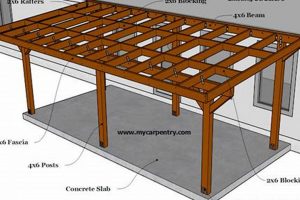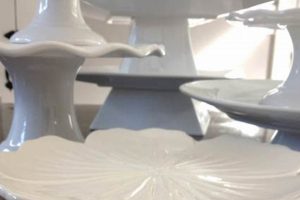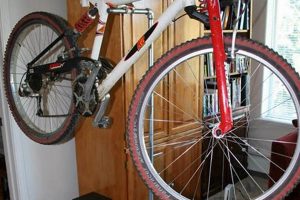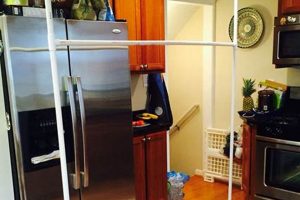Structures elevating plant containers from the ground, often constructed from repurposed or readily available materials, provide an aesthetic and functional solution for displaying flora. These supports can range from simple wooden platforms to intricate metal frameworks, offering a means of showcasing plants at varying heights and locations.
Elevating vegetation offers several advantages, including improved air circulation around the plant, reduced risk of ground-based pests, and the creation of visually appealing arrangements. Historically, elevating plant displays has been practiced in various cultures, often reflecting both horticultural and decorative sensibilities within domestic and public spaces.
The following sections will examine the diverse approaches to creating these elevated plant displays, detailing material selection, construction techniques, and considerations for stability and aesthetic integration within different environments.
Construction Guidance for Elevated Plant Displays
Achieving success in constructing stable and aesthetically pleasing elevated plant displays requires careful planning and execution. The following guidelines offer insights into key considerations for various build approaches.
Tip 1: Material Selection is Crucial: Opt for materials appropriate for the intended environment. Cedar and redwood exhibit natural resistance to moisture and decay, making them suitable for outdoor applications. Metal requires protective coatings to prevent rust formation.
Tip 2: Structural Integrity is Paramount: Ensure that the base is stable and capable of supporting the weight of the plant container and its contents. Reinforce joints with appropriate hardware and consider weight distribution when designing the structure.
Tip 3: Accurate Measurements are Essential: Prior to cutting any materials, meticulously measure and mark dimensions. Precision contributes to a professional finish and minimizes material waste.
Tip 4: Implement Protective Finishes: Apply sealants or paints to wood surfaces to enhance their longevity and resistance to environmental factors. Select finishes that are compatible with the chosen material and environmentally responsible.
Tip 5: Consider Drainage Requirements: If the design includes a tray or enclosed area beneath the plant container, ensure adequate drainage is provided to prevent water accumulation and potential root rot.
Tip 6: Aesthetic Integration is Important: Design the elevated plant display to complement the surrounding environment. Consider color schemes, textures, and overall style to achieve visual harmony.
Tip 7: Prioritize Safety Measures: When using power tools, adhere to all safety guidelines and wear appropriate protective equipment. Ensure that the finished structure is stable and does not pose a tipping hazard.
Careful attention to these aspects will improve both the structural integrity and the visual appeal of elevated plant displays. These considerations contribute to the longevity and enhanced functionality of the design.
The subsequent sections will delve into specific construction techniques, providing detailed instructions for building several types of elevated plant displays.
1. Material Durability
Material durability represents a foundational consideration in the context of constructing elevated plant displays. The longevity and structural integrity of these supports are directly contingent upon the selection of materials possessing inherent resistance to environmental degradation and physical stress. Choosing appropriate materials is not merely an aesthetic decision; it is a critical factor influencing the overall lifespan and functionality of the structure.
- Resistance to Moisture and Decay
Materials used in elevated plant support construction must withstand exposure to moisture, which can accelerate decay and compromise structural integrity. Wood species such as cedar and redwood exhibit natural resistance to rot, while pressure-treated lumber undergoes a chemical process that enhances its durability in damp environments. Failure to select moisture-resistant materials can lead to premature failure of the support structure, requiring costly repairs or replacements. Examples of unsuitable materials include untreated pine, which is susceptible to rapid degradation when exposed to moisture.
- Resistance to Insect Infestation
Certain wood species are susceptible to insect infestation, particularly by termites or wood-boring beetles, which can compromise the structural integrity of the plant support. Selecting materials that are naturally resistant to insect attack or applying appropriate wood preservatives can mitigate this risk. Untreated wood is a prime target for infestation, leading to structural weakening and potential collapse of the elevated plant support. Consideration should be given to the local climate and the prevalence of wood-destroying insects in the area.
- Resistance to UV Degradation
Exposure to ultraviolet (UV) radiation from sunlight can cause degradation in certain materials, particularly plastics and some types of wood finishes. UV degradation can lead to discoloration, cracking, and loss of structural integrity. Selecting materials that are inherently UV-resistant or applying UV-protective coatings can prolong the lifespan of the plant support. Outdoor plant displays are particularly vulnerable to UV damage, necessitating the selection of durable, UV-resistant materials.
- Resistance to Physical Stress and Load
The selected materials must be capable of withstanding the physical stress and load imposed by the weight of the plant container and its contents. This is particularly critical for elevated plant supports designed to accommodate large or heavy plants. Materials with inadequate strength can lead to structural failure, potentially resulting in damage to the plant, the support, or surrounding property. The load-bearing capacity of the materials should be carefully calculated to ensure the safety and stability of the structure.
The selection of durable materials represents a fundamental investment in the long-term performance of elevated plant displays. By considering factors such as moisture resistance, insect infestation, UV degradation, and load-bearing capacity, constructors can ensure that their creations withstand the test of time, providing a stable and aesthetically pleasing environment for their plants.
2. Structural Stability
Structural stability is a non-negotiable element in the design and construction of elevated plant platforms. The capacity of a support structure to bear the weight of a plant container and its contents without deformation or collapse is fundamental to its safe and effective operation.
- Material Rigidity and Load Capacity
The intrinsic stiffness of the selected materials dictates the structure’s resistance to bending or buckling under load. Wood species, metal gauges, and composite materials each possess distinct load-bearing capabilities. An inadequate material selection results in potential deformation or catastrophic failure under the weight of the plant, soil, and water. For instance, using thin-gauge metal for a large planter can cause bending and eventual collapse.
- Joint Integrity and Fastener Strength
The connection points within the plant support represent critical areas of vulnerability. The method of joining materials, whether through screws, bolts, welding, or adhesive bonding, must be capable of withstanding shear, tension, and compression forces. Insufficient fastener strength or poorly executed joints compromise the overall structural integrity, increasing the risk of joint separation and subsequent collapse. A poorly screwed joint in a wooden stand, for example, can easily separate under a heavy load.
- Base Stability and Weight Distribution
The geometry of the base and the distribution of weight across its footprint directly influence the platform’s stability. A wide base with a low center of gravity enhances resistance to tipping. Uneven weight distribution can create stress concentrations, leading to localized failure. A narrow-based plant support loaded with a tall, heavy plant is prone to tipping, especially when subjected to wind or accidental contact.
- Environmental Factors and Material Degradation
Exposure to environmental elements, such as moisture, temperature fluctuations, and UV radiation, can degrade the structural integrity of materials over time. Wood can rot, metal can corrode, and plastics can become brittle. Regular inspection and maintenance are essential to identify and address any signs of material degradation, preventing potential structural failure. An untreated wooden plant stand left outdoors will eventually rot and lose its structural integrity.
The structural integrity of elevated plant displays is paramount for ensuring plant safety, preventing property damage, and maintaining aesthetic appeal. Careful consideration of material properties, joint construction, base stability, and environmental factors is essential for building durable and reliable plant support structures. Ignoring any of these factors can lead to structural deficiencies, potentially endangering plants and surroundings.
3. Drainage Adequacy
Drainage adequacy is an indispensable element within the domain of elevated plant supports. The capacity of a plant container and its associated stand to facilitate the removal of excess water directly influences the health and vitality of the plant. Insufficient drainage creates an environment conducive to root rot, fungal diseases, and anaerobic soil conditions, inhibiting nutrient uptake and ultimately leading to plant decline or death. Conversely, excessive drainage can result in rapid soil dehydration, necessitating more frequent watering and potentially causing nutrient deficiencies. The design and construction of these elevated structures, therefore, necessitate careful attention to drainage characteristics to ensure optimal plant health. Consider, for example, a wooden elevated stand with a built-in planter box. If the box lacks drainage holes, water will accumulate, saturating the soil and suffocating the plant roots. This illustrates the direct cause-and-effect relationship between inadequate drainage and negative plant outcomes.
The implementation of effective drainage solutions within elevated plant platforms encompasses various practical considerations. The size and placement of drainage holes are critical factors. Larger holes may promote rapid drainage but could also lead to soil erosion. Smaller holes offer controlled drainage but may become clogged over time. The selection of appropriate potting mix also plays a vital role. A well-draining mix, typically incorporating perlite, vermiculite, or coarse sand, enhances aeration and prevents waterlogging. Furthermore, the use of a gravel layer at the bottom of the container can improve drainage by creating a reservoir for excess water, although this practice is debated as it can raise the water table within the container. The design of the stand itself can contribute to drainage; for example, a slatted base allows for air circulation and promotes evaporation of excess moisture. Examples of well-designed stands often incorporate a slight slope to facilitate water runoff.
Achieving proper drainage in elevated plant displays requires a holistic approach, integrating design, material selection, and horticultural best practices. Overcoming the challenges associated with inadequate drainage is crucial for maintaining plant health and prolonging the lifespan of these structures. The ability to manage water effectively contributes significantly to the overall success of elevated plant arrangements, reinforcing the need for careful planning and execution in their design and construction. Ignoring drainage considerations can lead to easily avoidable plant failures, underscoring the practical significance of understanding and addressing this fundamental aspect of elevated plant support systems.
4. Height Variation
Height variation, when deliberately integrated into elevated plant displays, introduces visual dynamism and functional benefits to indoor and outdoor spaces. The strategic manipulation of verticality enhances aesthetic appeal, optimizes plant health, and adapts to diverse spatial constraints. Considerations of height within these structures extend beyond mere aesthetic preference, influencing light exposure, accessibility, and overall horticultural success.
- Visual Hierarchy and Focal Points
Varying the height of elevated plant supports generates visual interest by creating a hierarchy of elements within a landscape or interior space. Taller stands draw the eye upward, establishing focal points and providing a sense of depth, while lower stands create a grounded effect. This manipulation of visual planes can transform a monotonous arrangement into a dynamic and engaging display. For example, a collection of succulents, displayed on stands of differing heights, naturally draws attention to the tallest, most visually striking specimen, while the lower stands provide a complementary backdrop.
- Light Exposure and Plant Requirements
Height directly influences the amount of light received by a plant. Elevating light-demanding species on taller stands ensures optimal exposure, while placing shade-tolerant plants on lower levels provides a more suitable environment. In instances where ambient light is limited, varying plant heights can maximize the utilization of available illumination. An indoor herb garden, for instance, might benefit from placing basil and rosemary on taller stands to capture the most sunlight, while mint and parsley thrive at lower elevations.
- Accessibility and Maintenance
Elevated plant structures of varying heights can improve accessibility for watering, pruning, and other maintenance tasks. Raising plants to a more convenient level reduces the need for bending or kneeling, minimizing physical strain. This is particularly beneficial for individuals with limited mobility. A tiered arrangement of plants on different height stands can make the tending process easier and more efficient, particularly for larger collections.
- Spatial Optimization and Vertical Gardening
In constrained spaces, height variation can maximize the utilization of vertical surfaces for gardening. Stacking plants on stands of differing heights creates a layered effect, transforming walls and corners into vibrant displays. This approach is particularly effective in urban environments where horizontal space is limited. Consider a balcony garden where a series of staggered plant stands creates a dynamic vertical garden, increasing the overall plant density and visual impact without occupying excessive floor space.
The thoughtful incorporation of height variations in the design of elevated plant structures yields significant advantages, ranging from enhanced visual appeal to improved plant health and accessibility. These multifaceted benefits underscore the importance of considering height as a key design element in the creation of dynamic and functional plant displays.
5. Aesthetic Integration
Aesthetic integration, in the context of DIY planter stands, denotes the harmonious blending of the structure with its surrounding environment. The success of such a project hinges on the extent to which the stand complements the architectural style, existing dcor, and the visual characteristics of the plants it supports. A failure to consider aesthetic integration can result in a visually jarring element that detracts from the overall appeal of the space. For example, a rustic wooden stand may appear incongruous within a modern, minimalist interior, thereby diminishing its intended function as an enhancement to the environment. The selection of materials, colors, and design elements directly contributes to this integration, acting as a causal factor in the stand’s perceived success or failure.
Achieving aesthetic integration requires a considered approach. The designer must assess the existing color palette of the space, the prevailing style of furniture and accessories, and the inherent characteristics of the plants themselves. For instance, a brightly colored ceramic planter might be best paired with a simple, understated stand that allows the plant to remain the focal point. Conversely, a more subdued planter could be elevated by a stand with intricate detailing or a unique design. Practical applications of this principle extend to material selection; stands constructed from reclaimed wood can integrate seamlessly into bohemian or farmhouse-style interiors, while metal stands may align more effectively with industrial or contemporary designs. The understanding of these relationships provides a framework for making informed design choices that elevate the overall aesthetic.
In summary, aesthetic integration is a critical component of successful DIY planter stand projects. It moves beyond mere functionality to encompass the visual impact and harmony of the stand within its intended setting. Challenges in achieving integration often arise from a lack of initial planning or a failure to consider the existing environment. By prioritizing aesthetic considerations alongside structural integrity and horticultural needs, one can create plant stands that not only support plant life but also enhance the beauty and cohesion of the surrounding space. This understanding connects directly to the broader theme of thoughtful design and its capacity to improve the quality of our environments.
6. Weight Capacity
Weight capacity constitutes a primary engineering consideration in the construction of elevated plant platforms. The ability of a DIY planter stand to safely support the combined weight of the container, soil, and plant material is paramount to its structural integrity and longevity. Failure to accurately assess and accommodate load requirements can result in structural failure, potential injury, and damage to property.
- Material Selection and Load-Bearing Strength
The selection of construction materials directly dictates the weight-bearing capacity of the stand. Wood species possess varying compressive and flexural strengths; hardwoods generally outperform softwoods in load-bearing applications. Similarly, the gauge and type of metal used in construction determine its resistance to deformation under load. Accurate material selection requires a thorough understanding of material properties and appropriate safety factors to account for unexpected loads or material degradation over time. As an example, a stand constructed of thin-walled aluminum tubing will exhibit a significantly lower weight capacity than one fabricated from solid oak lumber of comparable dimensions.
- Joint Design and Structural Integrity
Joints represent critical points of potential failure in any structural assembly. The type of joint employed, whether it be a mortise and tenon, a bolted connection, or a welded seam, must be capable of withstanding the applied load without deformation or separation. Inadequate joint design or improper execution can significantly reduce the overall weight capacity of the stand. A poorly constructed joint in a wooden stand, for instance, may fail prematurely under a load far below the theoretical capacity of the lumber used.
- Distribution of Load and Stability
The manner in which the load is distributed across the stand’s structure affects its stability and overall weight capacity. Even weight distribution minimizes stress concentrations and reduces the likelihood of localized failure. A wide base and a low center of gravity enhance stability and prevent tipping, particularly when supporting heavy or top-heavy plants. Asymmetrical loading or an unstable base can compromise the stand’s ability to safely bear weight, even if the materials and joints are adequately strong.
- Environmental Factors and Material Degradation
Exposure to environmental elements, such as moisture, temperature fluctuations, and UV radiation, can gradually degrade the strength and weight-bearing capacity of construction materials. Wood can rot, metal can corrode, and plastics can become brittle, reducing the stand’s ability to safely support its intended load. Regular inspection and maintenance are essential to identify and address any signs of material degradation and ensure the continued structural integrity of the stand. Neglecting these factors can lead to unexpected failures, particularly in outdoor applications.
The safe and reliable operation of DIY planter stands hinges upon a thorough understanding and careful consideration of weight capacity. Accurate material selection, sound joint design, balanced load distribution, and proactive maintenance are essential to ensure that these structures can safely and effectively support the intended load over their lifespan. Failing to account for these factors can result in potentially hazardous conditions and ultimately negate the benefits of elevated plant displays.
7. Environmental Suitability
Environmental suitability, in the context of crafting plant stands, encompasses the alignment of the stand’s materials, design, and construction with the specific conditions of its intended surroundings. Failure to address environmental factors can result in premature degradation of the structure, harm to the plant, and potential disruption of the surrounding ecosystem.
- Material Resistance to Climate
The chosen materials must withstand the prevailing climate conditions. Outdoor stands require resistance to moisture, UV radiation, and temperature fluctuations. Untreated wood, for example, will quickly deteriorate in wet or humid environments, while certain plastics can become brittle under prolonged sun exposure. Material selection should align with the local climate to ensure longevity and minimize maintenance. An example is the use of naturally rot-resistant cedar in areas with high rainfall.
- Impact on Soil and Water Quality
Materials used in plant stand construction should not leach harmful chemicals into the soil or surrounding water sources. Treated lumber, for instance, may contain preservatives that can contaminate the soil, potentially harming the plant and impacting the local ecosystem. Sustainable and non-toxic materials are preferable, particularly for edible plants or areas near water bodies. The use of reclaimed wood with unknown treatments should be carefully assessed.
- Structural Adaptation to Site Conditions
The stand’s design must account for the specific site conditions, such as uneven terrain, wind exposure, and proximity to other structures. A tall, narrow stand may be unstable in windy locations, requiring modifications such as a wider base or anchoring system. Uneven ground may necessitate adjustable feet or a self-leveling design. A stand placed against a building may require weatherproofing on the rear surface to prevent moisture damage.
- Compatibility with Plant Needs
The stand’s design should consider the specific needs of the plants it will support. Stands for shade-loving plants should minimize direct sunlight exposure, while stands for sun-loving plants should maximize light capture. Adequate drainage is crucial to prevent root rot, and proper ventilation can help prevent fungal diseases. A poorly designed stand can create an unfavorable microclimate, hindering plant growth and overall health. For example, a stand constructed from dark-colored metal can absorb excessive heat, potentially stressing heat-sensitive plants.
The successful integration of plant supports requires a holistic understanding of the interplay between materials, design, and environmental factors. Careful attention to these considerations will ensure the creation of plant stands that are both aesthetically pleasing and ecologically sound, promoting plant health and minimizing environmental impact.
Frequently Asked Questions
This section addresses common inquiries regarding the design, construction, and implementation of elevated plant displays, providing concise and objective answers.
Question 1: What constitutes the primary advantage of utilizing elevated plant structures?
Elevated plant displays enhance air circulation around the plant, mitigate ground-based pest access, and facilitate visually appealing arrangements within limited spaces.
Question 2: What materials are generally deemed suitable for constructing durable outdoor plant supports?
Weather-resistant materials, such as cedar, redwood, and treated lumber, are commonly employed. Metal structures require protective coatings to prevent corrosion in outdoor environments.
Question 3: How does drainage impact the longevity of a plant within an elevated display?
Adequate drainage prevents water accumulation and root rot. Incorporating drainage holes and utilizing well-draining potting mixes are crucial for maintaining plant health.
Question 4: To what extent should weight distribution be considered in plant support design?
Even weight distribution is essential for structural stability. Uneven loads can lead to stress concentrations and potential failure, particularly with heavy or top-heavy plants.
Question 5: How does height variation contribute to the aesthetic appeal of plant arrangements?
Strategically varying plant heights creates visual interest and establishes focal points. It enhances depth and dynamism within a display, transforming monotonous arrangements.
Question 6: What safety precautions are paramount when constructing plant supports?
Adherence to power tool safety guidelines, use of protective equipment, and ensuring structural stability are essential to mitigate potential hazards during the construction process.
These frequently asked questions offer guidance for constructing effective and aesthetically pleasing elevated plant structures, underlining the importance of careful planning and execution.
The subsequent section explores specific design examples, offering detailed construction plans for a variety of elevated plant displays.
Conclusion
The preceding exploration of diy planter stands has illuminated critical aspects of their design, construction, and integration within varied environments. The information presented underscores the importance of material selection, structural integrity, drainage adequacy, aesthetic harmony, load-bearing capacity, and environmental compatibility. Successfully constructed diy planter stands represent a convergence of engineering principles and horticultural understanding.
The future of elevated plant displays hinges on continued innovation in sustainable material sourcing and design optimization. Further exploration into modular and adaptable designs will enhance their versatility and broaden their application across diverse settings. A commitment to meticulous planning and skillful execution remains paramount for realizing the full potential of elevated plant displays in both functional and aesthetic terms.







